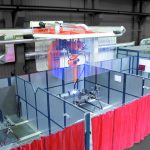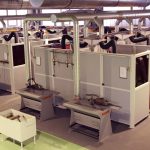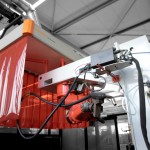Self-learning extraction technology: Has AI already arrived in welding fume extraction?
The digitalisation of metal processing is moving forward. Some manufacturers are already talking about the use of AI in welding fume extraction. But has artificial intelligence really arrived in air purification technology in practice? Fact check.
The digital revolution in the industry is in full swing – and, with it, new solutions are constantly being developed for metal processing as well. At the end of this development are self-learning robots with controllers that, depending on external influences, calculate the optimum composition of filler materials, inert gas and air volume flow of the extraction system and communicate independently with other machines.
Even in air purification technology, machine learning seems to have already arrived. Because with AI in welding fume extraction (read here why this is important), the first manufacturers are advertising their extraction systems, filter units and general ventilation systems. We provide the answers to the most important questions in the fact check. Is this already real AI in welding fume extraction or is it in name only?
AI in welding fume extraction: Definition and status quo
- What exactly is artificial intelligence?
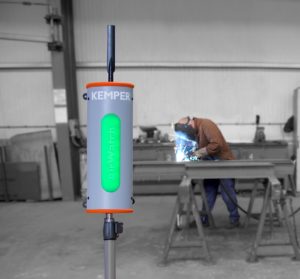 Artificial intelligence is a complex field for which there is no precise definition – not least because it is constantly evolving. The basic idea is to create “intelligent” computers or machines that are self-learning and work independently on problems. So AI is there to accomplish tasks that would normally require the intelligence of a human to solve.
Artificial intelligence is a complex field for which there is no precise definition – not least because it is constantly evolving. The basic idea is to create “intelligent” computers or machines that are self-learning and work independently on problems. So AI is there to accomplish tasks that would normally require the intelligence of a human to solve.
- When manufacturers of AI in the extraction of welding fumes speak in terms of air purification control technology today: What does this mean in concrete terms?
This refers to an automated filter and control concept within the filter system that enables efficient cleaning of the filters and thus significantly extends their service life. Behind this is the cleaning method known as differential pressure-dependent cleaning. The unit control defines these independently without human intervention.
- Is this procedure actually new?
No, this is a principle according to which modern filter units for welding fume extraction have been in operation for a long time. For example, KEMPER GmbH has been using the system in its central filter units for more than 15 years. But there is no mention of artificial intelligence here. In reality, the principle is called ‘delayed cleaning start’.
- What are the advantages for metal processing companies?
The principle of the delayed cleaning start considerably increases the efficiency of the extraction and filter units – this significantly extends the filter service life. In addition, it reduces the consumption of compressed air and, consequently, the usually high costs for businesses. Therefore: Companies save hard cash on maintenance and operating costs.
AI in welding fume extraction is actually the delayed cleaning start
- What does the delayed cleaning start actually do?
One minute after switching on the filter unit, it independently stores the differential pressure value on the basis of the filter saturation. Then it automatically adds 200 Pa. This total results in the current threshold for the cleaning start. Only when this differential pressure is exceeded does the filter unit automatically clean the filter elements. The differential pressure in the system is continuously determined during operation of the system – via sensitive sensor system. When the system cleans the filters, the differential pressure drops automatically.
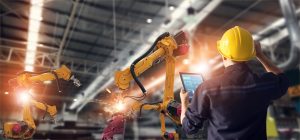 After two hours, the system automatically updates the filter cleaning threshold based on the new value. The actual differential pressure in the machine is determined, the standardised 200 Pa are added and a new threshold results. The effects of short-term pressure fluctuations are eliminated by only allowing a change in the start of cleaning in maximum steps of 100 Pa. This means that the system only cleans according to the filter saturation, which significantly reduces energy costs. This works in a window from 500 to 1,500 Pa. Each time the machine is switched on, the procedure is restarted as described above.
After two hours, the system automatically updates the filter cleaning threshold based on the new value. The actual differential pressure in the machine is determined, the standardised 200 Pa are added and a new threshold results. The effects of short-term pressure fluctuations are eliminated by only allowing a change in the start of cleaning in maximum steps of 100 Pa. This means that the system only cleans according to the filter saturation, which significantly reduces energy costs. This works in a window from 500 to 1,500 Pa. Each time the machine is switched on, the procedure is restarted as described above.
- Is the term AI the correct term at all in the context of welding fume extraction?
The term AI is a very pompous name for this procedure in welding fume extraction. The topics of differential pressure control and delayed cleaning are far removed from machine learning. Otherwise, it could be claimed that filter systems have been benefiting from AI since shortly after the turn of the millennium. Rather, the system is a fully developed procedure for increasing efficiency.
- What can welders expect with regard to AI in welding fume extraction in the future?
Welding fume extraction is also continuing to develop. But this has only a secondary connection with filter cleaning, however. There are already digital concepts that link the extraction and filter units, general ventilation systems, air monitoring systems and cloud platforms. This is not just based on autonomous machine-to-machine communication where extraction and filter units are only switched on automatically if there is a danger of exceeding limit values. It is also a step towards “Smart Maintenance”, where maintenance processes are made more efficient for an entire production line rather than a single system.



